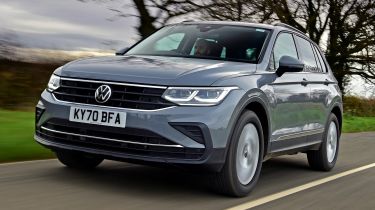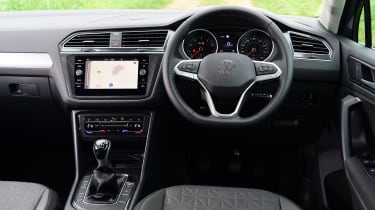New Volkswagen Tiguan Life 2020 review
Does the updated Volkswagen Tiguan make the most sense in base-spec Life trim? We find out...

Verdict
If you want a no nonsense family SUV that can transport a family of five in relative comfort at an affordable price, then the Tiguan remains thoroughly recommendable. The sacrifice is that, as a base-spec Life model, it’s an SUV lacking any sort of excitement. However, the breadth of the Tiguan range does mean there’s something for everyone, from a fuel-sipping plug-in hybrid to a potent R.
You don't become the most successful model within the entire VW Group by being divisive. A daring design isn’t going to help you achieve almost one million sales in a single year - that’s how many Tiguans were sold in 2019. It's a crowd-pleasing approach that’s going to help pull in as many customers as possible.
So when VW came to update its latest Tiguan, driven here in the UK for the first time, you can guarantee there was one simple instruction: change as little as possible. From the outside, this revised Tiguan has been sharpened up slightly at the front with a pair of reshaped LED headlamps and sleeker grille, but along the flanks and at the rear it’s a case of spot the difference.
In entry-level Life spec, like our test car, it’s a pretty forgettable-looking SUV. Especially in grey. A racier R-Line trim does inject the Tiguan with a bit more visual-appeal, courtesy of a more aggressive body kit and larger alloy-wheels, but it’s a £4,500 premium, which is quite a chunk of cash.
Used - available now

2024 Volkswagen
Tiguan
17,314 milesAutomaticDiesel2.0L
Cash £27,261
2023 Volkswagen
Tiguan
14,963 milesAutomaticPetrol1.5L
Cash £29,138
2024 Volkswagen
Tiguan
51,795 milesAutomaticDiesel2.0L
Cash £24,687
2023 Volkswagen
Tiguan
29,275 milesAutomaticPetrol1.5L
Cash £23,100If you were hoping VW was saving all of its design budget for a big overhaul inside, well, you’ll be disappointed. It remains a perfectly functional cabin and one that’s very easy to get comfortable in, but it’s all a little bit drab and, in a somewhat twisted irony to the spec of our Tiguan, lifeless. There’s swathes of grey everywhere you look - on the dashboard, the seats and centre console.
A new touch-sensitive climate control cluster and new-look eight-inch infotainment system do look a lot slicker than before, but they don’t really do enough to transform what is a rather uninspiring place to spend time. Opt for Life spec and you’ll also have to make do with conventional dials rather than a slicker digital set-up most customers will have become accustomed to by now. The Peugeot 3008 is, by some margin, the more appealing and sophisticated SUV inside and out - that’s not something you would have said five years ago.
Our test car was fitted with the VW Group’s familiar 148bhp 1.5-litre four-cylinder turbo engine, here paired with a six-speed manual gearbox that sends power to the front wheels. As specifications go it’s as entry-level as a Tiguan gets and costs just under £28,000.
Little has changed in the way the Tiguan drives, which is to say that it’s a polished, easy and refined SUV - if one that is devoid of any sort of excitement. The 1.5-litre engine is a known quantity; power delivery is smooth and at a cruise the engine totally fades into the background.
With only 250Nm of torque on offer, there isn't a huge deal of grunt to get you moving anywhere particularly quickly. That amount of power in a Golf isn’t an issue, but the Tiguan’s extra weight counts against it here when accelerating from a standstill. Once above 3,000rpm the engine gets into its stride but if you plan on loading the Tiguan up with children and luggage regularly the extra torque of the 2.0-litre TSI would be welcome.
The six-speed manual has a light and precise action, but a seven-speed DSG automatic is available as a £1,600 option. Unless you plan on regular off-roading or live off the beaten track, front-wheel drive will be just fine. Four-wheel drive can only be had with more expensive Elegance and R-Line models with a 2.0-litre diesel engine and DSG gearbox, which means you’ll have to stump up at least £35,230.
The only small gripe with the Tiguan is the slightly firm ride. It’s not what you’d call uncomfortable but there is a brittleness to the ride over slightly broken surfaces even on our car’s 18-inch alloy wheels.
On the move you’ll also begin to notice that while some of the changes VW has made to the cabin look like an improvement, the reality is a little different. Trying to adjust the climate controls using the new touch sensitive strip, that you have to slide your finger across to adjust, is almost impossible to do while driving. It’s the same story with the shortcut keys for the navigation; physical buttons have been replaced with a smooth plastic surface, which leaves you jabbing at the screen in the hope you hit the right button.
There’s enough standard kit on Life spec Tiguans to make it the model to go for. An eight-inch infotainment system, 18-inch alloys, climate control, adaptive cruise control, parking sensors and sat-nav all come as standard.
Stepping up to Elegance or R-Line trim adds a larger infotainment system, digital dials, bigger alloys and a rear-view parking camera, but if you want the 1.5-lite TSI you also have to have a seven-speed DSG, which makes it a £4,500 premium over a the model we have here.
Whichever you go for, the Tiguan remains a perfectly practical family SUV. The 520-litre boot is a great size and dropping the rear bench increases that space to 1,655 litres. However, there is a noticeable lip when you, which could make loading longer or bulkier items a little more difficult, but there is ample space in the back for adults.
| Model: | Volkswagen Tiguan Life 1.5 TSI |
| Price: | £27,980 |
| Engine: | 1.5-litre 4cyl turbo |
| Transmission: | Six-speed manual, front-wheel drive |
| Power/torque: | 148bhp/250Nm |
| 0-62mph: | 9.9 seconds |
| Top speed: | 126mph |
| Economy: | 42.6mpg |
| CO2: | 151g/km |
| On sale: | Now |











